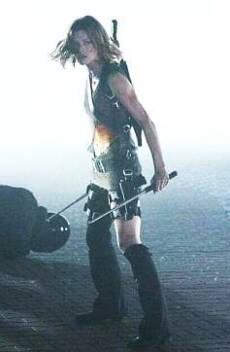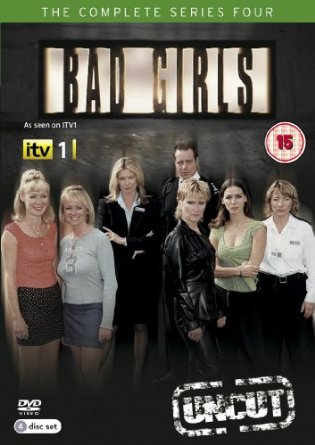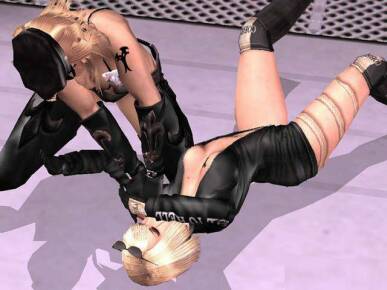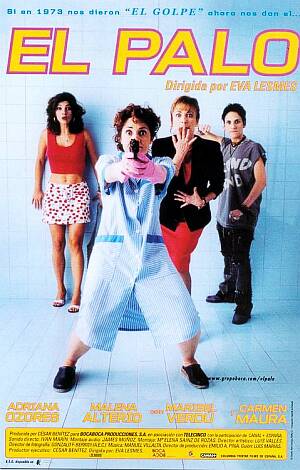 ★★★★
★★★★
“Apocalypse NOW…”
 The history of cinema has provoked many furious arguments as to which is better. Dracula or Frankenstein? Moore or Connery? Alien or Predator? And now we can add another to the list: tank-top or bustier? For we have not one, but two action heroines here, both finely-honed killing machines, with slightly different though similarly-slutty tastes in clothing. That really tells you all you need to know about this sequel, which never lets practical issues like plot – or costume – get in the way of the gratuitous violence.
The history of cinema has provoked many furious arguments as to which is better. Dracula or Frankenstein? Moore or Connery? Alien or Predator? And now we can add another to the list: tank-top or bustier? For we have not one, but two action heroines here, both finely-honed killing machines, with slightly different though similarly-slutty tastes in clothing. That really tells you all you need to know about this sequel, which never lets practical issues like plot – or costume – get in the way of the gratuitous violence.
Numerous reviews have complained about the lacklustre scripting, poor characterisation, etc to be found here. Hello! It’s based on a computer game! And a proper one, about shooting zombies, not wussy nonsense like finding jobs or raising children, fans of The Sims please note. Plus, it’s a sequel to boot, and if you expect sensitive drama from any film whose title contains the words “Evil” and “Apocalypse”, you simply need to get out more. It’s called expectation management, people.

 The tactic here was simple and clear. Keep all the good stuff from the original, e.g. Milla Jovovich, zombie dobermans, and throw a few new elements in, this time including some stuff which, unlike Jovovich’s character, Alice, actually has a significant connection to the game. Hence, you get Jill Valentine (Guillory), a special forces chick who, in most other movies, would be the heroine, but is here largely to show you how Alice v2.0 has been improved beyond human. It’s reminiscent of how Ripley, by Alien Resurrection, had partly been transformed into what she was fighting, and Alice is now faster, stronger and cooler than she was last time – which is something of an achievement in itself.
The tactic here was simple and clear. Keep all the good stuff from the original, e.g. Milla Jovovich, zombie dobermans, and throw a few new elements in, this time including some stuff which, unlike Jovovich’s character, Alice, actually has a significant connection to the game. Hence, you get Jill Valentine (Guillory), a special forces chick who, in most other movies, would be the heroine, but is here largely to show you how Alice v2.0 has been improved beyond human. It’s reminiscent of how Ripley, by Alien Resurrection, had partly been transformed into what she was fighting, and Alice is now faster, stronger and cooler than she was last time – which is something of an achievement in itself.
The story more or less picks up immediately after the events of the original, with the zombiefying T-virus now loose in Raccoon City – hence an almost infinite supply of the undead. The Umbrella Corporation quarantine the place, but the daughter of their top scientist is still inside. He tracks down the human survivors inside and tells them if they rescue his offspring, he’ll get them all out of the city before it’s turned into a mushroom cloud. But just to spice things up, the top Umbrella creation, Nemesis, is now also loose in the city, using it as a testing ground.
There are, I will admit, absolutely no surprises in the plot at all. When someone comes up to “rescue” a small child who is facing resolutely away from the camera, you know that little girl will inevitably turn out to be a zombie. But guess what? I really wouldn’t have it any other way. Much like Shakespeare(!), this kind of film isn’t about unexpected twists in the plot, it’s about the execution, and that’s where this film delivers solidly.
 Or at least, mostly solidly – let’s get the criticism out of the way first. Witt wants to stick the camera right in there, when what we want to do is fully appreciate the grace and athleticism of the heroines, not suffer from motion sickness. Also: hello, “R”-rating? Presumably this was for the language, topless undead hookers, and Milla’s scarily-large nipples (Chris pointed out they’re almost larger than her breasts), because it certainly wasn’t for the gore. These monsters were almost bloodless, even when shot through the head or exploded by hand-grenade – the latter would seem dangerous when you’re dealing with a highly-infectious, fluid-borne disease, but I’m quibbling here.
Or at least, mostly solidly – let’s get the criticism out of the way first. Witt wants to stick the camera right in there, when what we want to do is fully appreciate the grace and athleticism of the heroines, not suffer from motion sickness. Also: hello, “R”-rating? Presumably this was for the language, topless undead hookers, and Milla’s scarily-large nipples (Chris pointed out they’re almost larger than her breasts), because it certainly wasn’t for the gore. These monsters were almost bloodless, even when shot through the head or exploded by hand-grenade – the latter would seem dangerous when you’re dealing with a highly-infectious, fluid-borne disease, but I’m quibbling here.
Otherwise, the film takes the right pieces and puts them together in the right order, which is a good deal more than we’ve come to expect from any big-budget Hollywood action movie [Yes, I’m talking to you, Van Helsing and LXG]. The Nemesis monster is one creepy-looking dude, and Alice’s encounters with him are the stuff of nightmares. Another highlight is the return of the lickers, in a church through whose stained-glass windows Alice comes crashing on a motorbike, at the start of one very cool sequence. [Incidentally, to answer the “Why did she do that?” question raised by many reviewers, I assume she was attracted to the scene by the gunshots.]
 As mentioned, the undead attack canines are also back, and just as bad as before; this time, it’s mostly Valentine who has to deal with them, at least until the end, when Alice effortlessly one-ups her rival yet again. We briefly muttered “catfight!” under our breath, and it’d certainly have been fun to see Jill and Alice go toe-to-toe, but the outcome of that would be so predictable – Alice would win, without even breaking sweat – that its omission is understandable. The supporting characters do their job adequately; Mike Epps is the comic relief, something not really present in the first film, and manages the tricky task of doing the job without becoming annoying. Oded Fehr is somewhat irrelevant as a soldier also after the scientist’s daughter, while Sandrine Holt, playing journalist Terri Morales, is understandably overshadowed by Jill and Alice. On the Umbrella side…blah evil corporate drone, blah misunderstood scientist blah, blah. We don’t care – and nor should we.
As mentioned, the undead attack canines are also back, and just as bad as before; this time, it’s mostly Valentine who has to deal with them, at least until the end, when Alice effortlessly one-ups her rival yet again. We briefly muttered “catfight!” under our breath, and it’d certainly have been fun to see Jill and Alice go toe-to-toe, but the outcome of that would be so predictable – Alice would win, without even breaking sweat – that its omission is understandable. The supporting characters do their job adequately; Mike Epps is the comic relief, something not really present in the first film, and manages the tricky task of doing the job without becoming annoying. Oded Fehr is somewhat irrelevant as a soldier also after the scientist’s daughter, while Sandrine Holt, playing journalist Terri Morales, is understandably overshadowed by Jill and Alice. On the Umbrella side…blah evil corporate drone, blah misunderstood scientist blah, blah. We don’t care – and nor should we.
Looking around, there seemed to be two kinds of reviews for this: those who ‘get’ what’s intended here, and those who clearly don’t – partly, no doubt, powered by the fact that this wasn’t screened in advance for critics. Hell hath no fury like Roger Ebert forced to pay for his supersized bag of candy… How you react to the film will likely be similarly split; given you’re on this site, I suspect the odds are in favour of Apocalypse, for its strong intuitive grasp of the ingredients necessary in a good action heroine, and its delivery thereof. Sure, the plot is some way short of perfect, and more/better-filmed fights would have been welcome, but the makers do a sound job of distracting you from the flaws, and there’s enough worthwhile stuff that will stick in your mind, to put it in the top quarter of this summer’s popcorn flicks.
Dir: Alexander Witt
Star: Milla Jovovich, Sienna Guillory, Oded Fehr, Mike Epps

 The real strength of Bad Girls is the almost limitless possibilities of the scenario; if ever things are in danger of getting stale, it’s easy to lob in fresh characters to get the pot stirred up and create whatever angles you want. Exhibit A: new governor, Neil Grayling (Gadds), whose arrival gave the show a whole new direction, at least among the staff – and particularly Jim Fenner, who discovered a whole new viewpoint of sexual harassment. Not that it really made him see the error of his ways, of course.
The real strength of Bad Girls is the almost limitless possibilities of the scenario; if ever things are in danger of getting stale, it’s easy to lob in fresh characters to get the pot stirred up and create whatever angles you want. Exhibit A: new governor, Neil Grayling (Gadds), whose arrival gave the show a whole new direction, at least among the staff – and particularly Jim Fenner, who discovered a whole new viewpoint of sexual harassment. Not that it really made him see the error of his ways, of course.





 The opening shot zooms in on Rodriguez with her head down; slowly, she raises her head, and stares into the camera with ferocious intensity. If this renders the rest of the film largely redundant, it’s not really anyone’s fault. In Michelle Rodriguez, the makers have the perfect person to play Diana, a pissed-off, troubled/troublesome) teen, who finds that violence
The opening shot zooms in on Rodriguez with her head down; slowly, she raises her head, and stares into the camera with ferocious intensity. If this renders the rest of the film largely redundant, it’s not really anyone’s fault. In Michelle Rodriguez, the makers have the perfect person to play Diana, a pissed-off, troubled/troublesome) teen, who finds that violence  The picture on the right probably does a better job of explaining what Cutey Honey is about than I ever could; part-girl, part nano-technology, rebuilt post-car crash with superpowers and some interesting costumes, which require fuelling through junk food. After her uncle is kidnapped by the evil Sister Jill (Sakai) and his/her/its minions – Jill is part tree, and has also been kidnapping women en masse, in order to drain their lifeforce – only Cutie (Sato) can save the day, assisted by a no-nonsense policewoman (Ichikawa) and a journalist who, basically, acts as “Exposition-San” (Murakami).
The picture on the right probably does a better job of explaining what Cutey Honey is about than I ever could; part-girl, part nano-technology, rebuilt post-car crash with superpowers and some interesting costumes, which require fuelling through junk food. After her uncle is kidnapped by the evil Sister Jill (Sakai) and his/her/its minions – Jill is part tree, and has also been kidnapping women en masse, in order to drain their lifeforce – only Cutie (Sato) can save the day, assisted by a no-nonsense policewoman (Ichikawa) and a journalist who, basically, acts as “Exposition-San” (Murakami). ★★★★
★★★★
 It’s kinda hard to decide whether this is feminist or sexist. There’s no doubt that these are strong, independent women who can kick ass with the best of them. Yet they also wear outfits which would prove structurally unfeasible in real life, and you could say the same thing about physical attributes resembling a multiple Zeppelin pile-up. Then there’s “mud mode” (left), which is exactly what it sounds like. Of course, this cheesecake aspect is far from unheard of: Dead or Alive: Beach Volleyball took the female characters from the beat-em-up game and put them in swimsuits to play volleyball against each other. Yet, its roleplaying aspects made that one a favourite with our teenage
It’s kinda hard to decide whether this is feminist or sexist. There’s no doubt that these are strong, independent women who can kick ass with the best of them. Yet they also wear outfits which would prove structurally unfeasible in real life, and you could say the same thing about physical attributes resembling a multiple Zeppelin pile-up. Then there’s “mud mode” (left), which is exactly what it sounds like. Of course, this cheesecake aspect is far from unheard of: Dead or Alive: Beach Volleyball took the female characters from the beat-em-up game and put them in swimsuits to play volleyball against each other. Yet, its roleplaying aspects made that one a favourite with our teenage  My playing-style is your average button-masher, but it took me only an hour or so to beat the game with my first character – there are ten to choose from at the beginning, and playing through story mode in each one unlocks their alter-ego. Play through all 20, and you can be the bosses too, but be warned: the voice acting is horrible, and the storylines positively wince-inducing. In addition, you can play straightforward exhibition matches, and carrying out certain tasks, known as “vows” e.g. winning inside three minutes, can cause characters to switch from good to bad versions too. A problem here seems to be that you can’t have both alignments active simultaneously, so you’re not able to have Reiko Hinomoto (nice) take on Rowdy Reiko (naughty).
My playing-style is your average button-masher, but it took me only an hour or so to beat the game with my first character – there are ten to choose from at the beginning, and playing through story mode in each one unlocks their alter-ego. Play through all 20, and you can be the bosses too, but be warned: the voice acting is horrible, and the storylines positively wince-inducing. In addition, you can play straightforward exhibition matches, and carrying out certain tasks, known as “vows” e.g. winning inside three minutes, can cause characters to switch from good to bad versions too. A problem here seems to be that you can’t have both alignments active simultaneously, so you’re not able to have Reiko Hinomoto (nice) take on Rowdy Reiko (naughty). The graphics kick ass. An awful lot of polygons (I believe around 10,000!) go into each character, with detailed hair, costumes, tattoos, backgrounds and other refinements that look good even on the biggest TV set. However, when the wrestlers run, it sometimes doesn’t work at all. The music is pretty lame J-Pop, so you’ll probably rapidly find yourself turning off the entrance videos too. On the down side, as well as practice mode, we could have used tag matches, survival mode, create-a-character, a bigger range of locations… The options present here are pretty sparse, though in gaming I suppose it’s usually better not to be a jack-of-all-trades.
The graphics kick ass. An awful lot of polygons (I believe around 10,000!) go into each character, with detailed hair, costumes, tattoos, backgrounds and other refinements that look good even on the biggest TV set. However, when the wrestlers run, it sometimes doesn’t work at all. The music is pretty lame J-Pop, so you’ll probably rapidly find yourself turning off the entrance videos too. On the down side, as well as practice mode, we could have used tag matches, survival mode, create-a-character, a bigger range of locations… The options present here are pretty sparse, though in gaming I suppose it’s usually better not to be a jack-of-all-trades. Combining elements from Dead Like Me and Ghost, this still manages to come up with something unique, especially given its origins as a prequel to a popular TV series. It is designed to explain how Mina (Shaku) got the job as Keeper of the Gate, where murder victims must decide whether to forgo revenge and pass on, return to Earth as a ghost, or seek vengeance at the price of eternal torment. She ends up there after having her heart torn out on her wedding day by insane billionaire serial killer Kudo (Osawa) who will stop at nothing to save his one true love, currently lying in a coma. Trust me – it all makes perfect sense, and it’s a particularly nice touch that Mina’s fiance, Detective Kohei (Shosuke) is equally driven in his actions by love.
Combining elements from Dead Like Me and Ghost, this still manages to come up with something unique, especially given its origins as a prequel to a popular TV series. It is designed to explain how Mina (Shaku) got the job as Keeper of the Gate, where murder victims must decide whether to forgo revenge and pass on, return to Earth as a ghost, or seek vengeance at the price of eternal torment. She ends up there after having her heart torn out on her wedding day by insane billionaire serial killer Kudo (Osawa) who will stop at nothing to save his one true love, currently lying in a coma. Trust me – it all makes perfect sense, and it’s a particularly nice touch that Mina’s fiance, Detective Kohei (Shosuke) is equally driven in his actions by love.
 ★★★★
★★★★
 The tactic here was simple and clear. Keep all the good stuff from the original, e.g. Milla Jovovich, zombie dobermans, and throw a few new elements in, this time including some stuff which, unlike Jovovich’s character, Alice, actually has a significant connection to the game. Hence, you get Jill Valentine (Guillory), a special forces chick who, in most other movies, would be the heroine, but is here largely to show you how Alice v2.0 has been improved beyond human. It’s reminiscent of how Ripley, by Alien Resurrection, had partly been transformed into what she was fighting, and Alice is now faster, stronger and cooler than she was last time – which is something of an achievement in itself.
The tactic here was simple and clear. Keep all the good stuff from the original, e.g. Milla Jovovich, zombie dobermans, and throw a few new elements in, this time including some stuff which, unlike Jovovich’s character, Alice, actually has a significant connection to the game. Hence, you get Jill Valentine (Guillory), a special forces chick who, in most other movies, would be the heroine, but is here largely to show you how Alice v2.0 has been improved beyond human. It’s reminiscent of how Ripley, by Alien Resurrection, had partly been transformed into what she was fighting, and Alice is now faster, stronger and cooler than she was last time – which is something of an achievement in itself. Or at least, mostly solidly – let’s get the criticism out of the way first. Witt wants to stick the camera right in there, when what we want to do is fully appreciate the grace and athleticism of the heroines, not suffer from motion sickness. Also: hello, “R”-rating? Presumably this was for the language, topless undead hookers, and Milla’s scarily-large nipples (Chris pointed out they’re almost larger than her breasts), because it certainly wasn’t for the gore. These monsters were almost bloodless, even when shot through the head or exploded by hand-grenade – the latter would seem dangerous when you’re dealing with a highly-infectious, fluid-borne disease, but I’m quibbling here.
Or at least, mostly solidly – let’s get the criticism out of the way first. Witt wants to stick the camera right in there, when what we want to do is fully appreciate the grace and athleticism of the heroines, not suffer from motion sickness. Also: hello, “R”-rating? Presumably this was for the language, topless undead hookers, and Milla’s scarily-large nipples (Chris pointed out they’re almost larger than her breasts), because it certainly wasn’t for the gore. These monsters were almost bloodless, even when shot through the head or exploded by hand-grenade – the latter would seem dangerous when you’re dealing with a highly-infectious, fluid-borne disease, but I’m quibbling here. As mentioned, the undead attack canines are also back, and just as bad as before; this time, it’s mostly Valentine who has to deal with them, at least until the end, when Alice effortlessly one-ups her rival yet again. We briefly muttered “catfight!” under our breath, and it’d certainly have been fun to see Jill and Alice go toe-to-toe, but the outcome of that would be so predictable – Alice would win, without even breaking sweat – that its omission is understandable. The supporting characters do their job adequately; Mike Epps is the comic relief, something not really present in the first film, and manages the tricky task of doing the job without becoming annoying. Oded Fehr is somewhat irrelevant as a soldier also after the scientist’s daughter, while Sandrine Holt, playing journalist Terri Morales, is understandably overshadowed by Jill and Alice. On the Umbrella side…blah evil corporate drone, blah misunderstood scientist blah, blah. We don’t care – and nor should we.
As mentioned, the undead attack canines are also back, and just as bad as before; this time, it’s mostly Valentine who has to deal with them, at least until the end, when Alice effortlessly one-ups her rival yet again. We briefly muttered “catfight!” under our breath, and it’d certainly have been fun to see Jill and Alice go toe-to-toe, but the outcome of that would be so predictable – Alice would win, without even breaking sweat – that its omission is understandable. The supporting characters do their job adequately; Mike Epps is the comic relief, something not really present in the first film, and manages the tricky task of doing the job without becoming annoying. Oded Fehr is somewhat irrelevant as a soldier also after the scientist’s daughter, while Sandrine Holt, playing journalist Terri Morales, is understandably overshadowed by Jill and Alice. On the Umbrella side…blah evil corporate drone, blah misunderstood scientist blah, blah. We don’t care – and nor should we.




































